Data valid through October 8, 2024
Contents
TL; DR
- In a narrow sense, prediction markets typically exclude traditional gambling and sports betting. They focus more on information discovery and assisting public decision-making.
- Prediction markets cannot always be “accurate.” Failures often occur because people tend to treat the probabilities given by prediction markets as established facts.
- Cryptocurrencies have introduced freer transaction amounts and a more frictionless payment experience to prediction markets.
- The user profile of Polymarket is quite different from that of NFT traders, memecoin players, and other crypto-native users. Polymarket users tend to be older, less focused on maximizing risk-reward ratios, and more driven by strong motivations for information gathering and analysis.
- The key competitive factors for prediction market products lie in how they curate better-quality events and attract rational traders (content creators). Polymarket’s competitive edge stems from the attention (liquidity) it has garnered from its ability to break out into the mainstream.
- Polymarket is extremely cautious about incentivizing trading volumes and introducing more complex trading functions. New projects trying to enter the prediction market from a derivative trading angle may suffer from mismatched functionality and face challenges in gaining traction.
- After the election on November 5, Polymarket is expected to face a large withdrawal of liquidity. Public assessments of Polymarket’s performance during the election, as well as its next strategic steps, could have significant implications for the future of prediction markets.
The Rise of “That Prediction Market”
Polymarket is currently the largest “2024 U.S. Election Prediction Market.” Users have collectively placed nearly 1.5 billion dollars in bets on whether Harris or Trump will be the final winner. This figure leaves its Web2 competitors, PredictIt and Smarkets, far behind — with trading volumes for the same issue reaching 37 million and 9 million dollars, respectively.
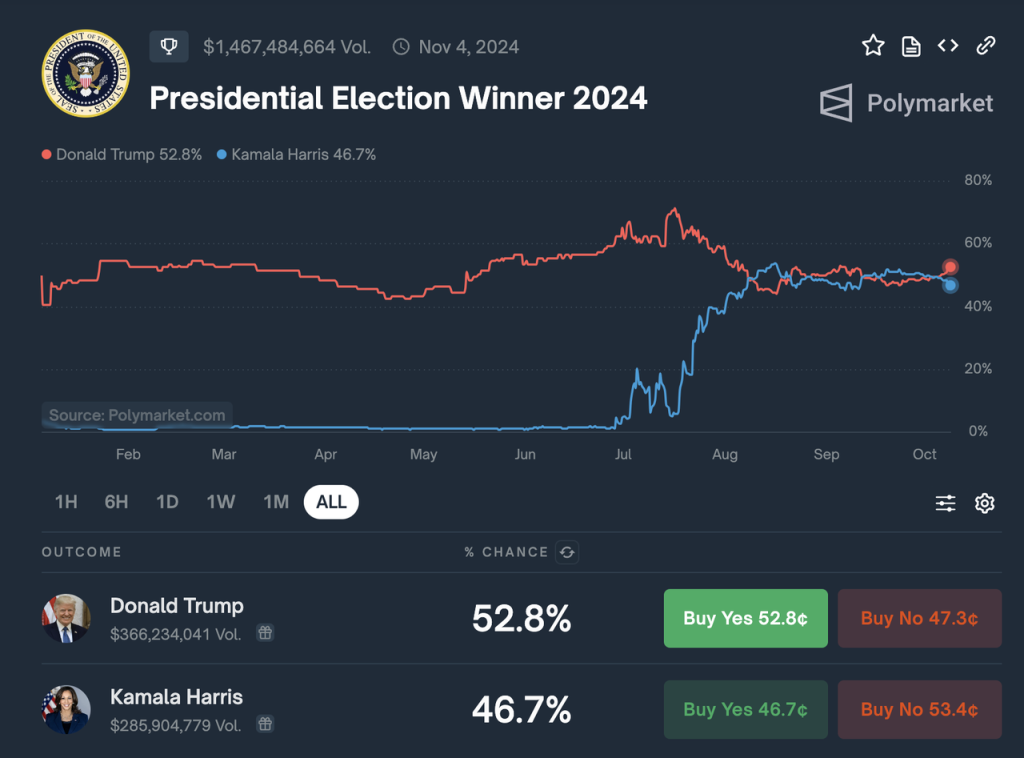
Conceptual Analysis of Prediction Markets
Broadly speaking, prediction markets evolved from gambling and betting markets, referring to markets where people invest money in the expected outcome of an event with the hope of receiving a return.
In a narrower sense, prediction markets usually exclude traditional gambling and sports betting, instead focusing on a broader range of political, economic, and cultural events. These markets emphasize the function of information discovery and may provide reference points for policy-making or public decisions. The concept of such prediction markets can be traced back at least to the early 16th century, during the papal elections. One of the earliest modern electronic prediction markets is the Iowa Electronic Markets, introduced during the 1988 U.S. presidential election.
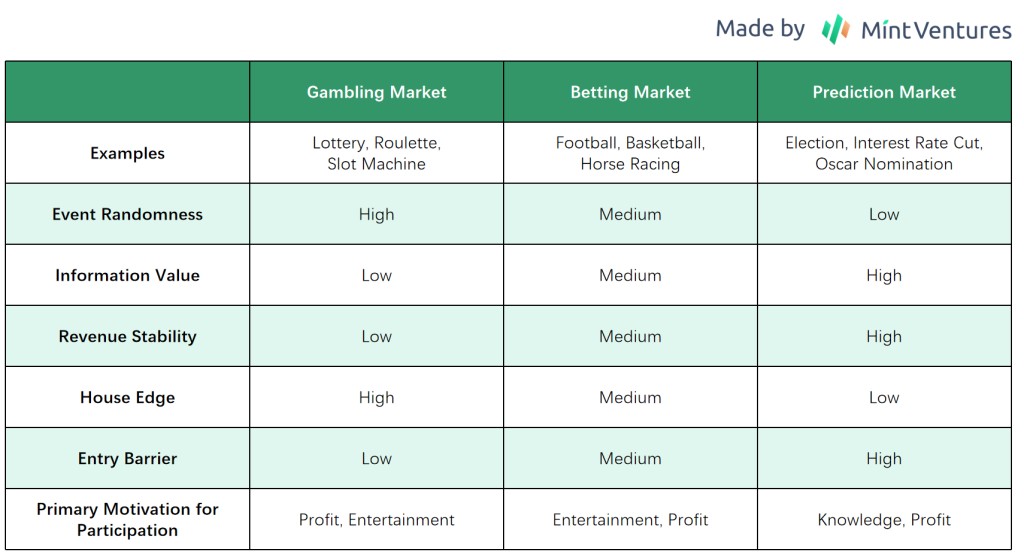
Are Crypto Prediction Markets Equal to Truth Machines?
Vitalik Buterin may be the most influential advocate of prediction markets in the Web3 world. As early as 2014, he discussed prediction markets as a practical example of Futarchy (a form of future governance Robin Hanson envisioned using betting markets to make policy decisions). In a 2020 article exploring mechanisms for “credible neutrality,” he again used prediction markets as a case study, even proposing a design where prediction markets could be tied to highly improbable events. In 2021, he published a systematic discussion of the value behind prediction markets and their decentralized advantages. In this current cycle, he has frequently expressed optimism about prediction markets and even participated in Polymarket’s Series B fundraising round in May.
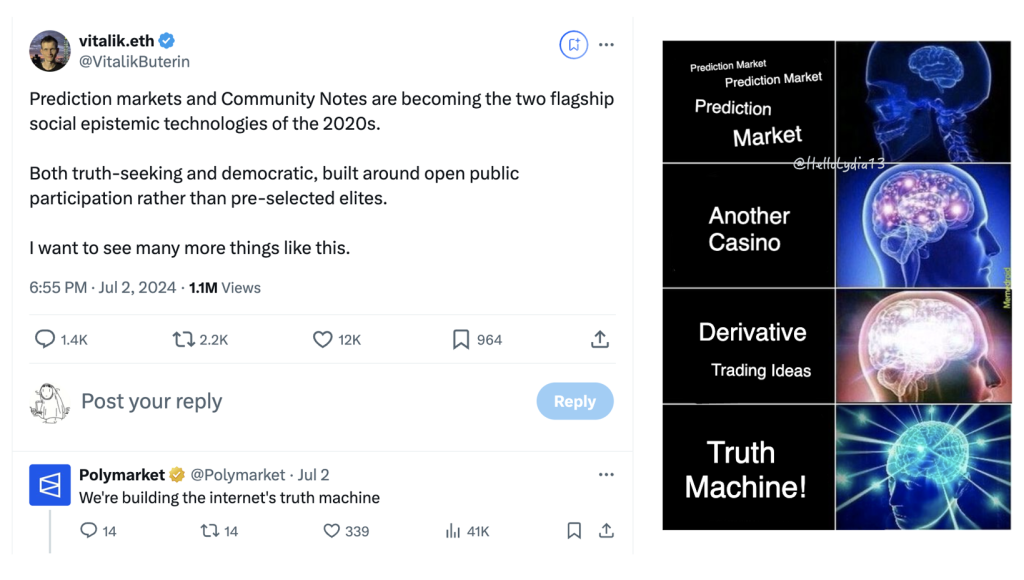
To understand the underlying principles of prediction markets, as well as the ambitious expectations crypto enthusiasts have for them, we can start by addressing three key questions:
- What do the prediction results represent?
- How accurate are prediction markets?
- What has cryptocurrency brought to prediction markets?
Due to space limitations, I will provide brief answers to these three questions.
- What do the prediction results of a prediction market represent? Are they the truth?
The notion of a “Truth Machine” is controversial. Prediction markets capture participants’ interpretations of symbolized events and use these interpretations as the basis for estimating future objective outcomes. However, this process does not generate the truth. Instead, it generates a probability estimate based on participants’ views about the event’s possible outcome. Even when predictions align with the actual result, this alignment is merely post hoc verification.
- How accurate are prediction markets?
The legitimacy of prediction markets can typically be traced back to thinkers like Hayek, the Bayesian Theorem, Futarchy, the Efficient Market Hypothesis, etc. In essence, it can be summarized in the following way: although knowledge is dispersed throughout human society, if there are enough market participants who continuously update their views based on new evidence, it can lead to the formation of an effective market where asset prices reflect all publicly available information, thereby helping to inform decision-making.
Supporters of prediction markets often cite examples such as the 2008 U.S. elections and Polymarket’s performance during the COVID-19 pandemic in 2020. However, the disappointing performance of prediction markets during the 2016 Brexit referendum and U.S. elections has weakened this argument. According to post-event reflections, one reason for this “failure” is that traders viewed the probabilities provided by the prediction markets as foregone conclusions, abandoning timely updates based on external information, which led to overly stable prices. This also hints at the reflexivity of prediction markets—where trust in them undermines the very foundation of their reliability.
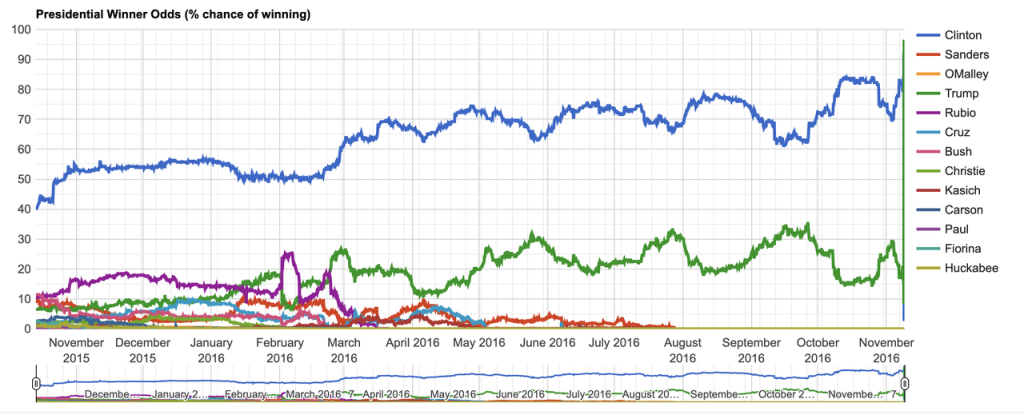
- What role has cryptocurrency played in the long history of prediction markets?
From the conceptual and practical perspective of prediction markets, decentralized prediction markets typically do not have any betting limits (compared to PredictIt’s betting cap of $850). This allows participants to more freely assign monetary weight to their opinions based on their level of confidence, potentially capturing market trends more accurately.
From an operational perspective, the use of cryptocurrency not only enables more instantaneous payment processing but also greatly reduces the proportion of customers requesting chargebacks through credit card companies (i.e., chargeback fraud). For instance, the well-known online gambling platform Stake only accepts cryptocurrency payments.
The Rise of Polymarket
A common question is: given that the concept and practice of prediction markets have been around for quite some time, and their combination with cryptocurrency is nothing new, why has it been Polymarket that emerged as a major player, competing successfully in the existing market to the point where it has almost become synonymous with “prediction market”?
First, it’s worth mentioning that 2024 is an exceptional year in terms of global elections. According to incomplete statistics, in 2024, 76 countries/regions will hold elections, covering a population of 4.17 billion. Among them, the U.S. election undoubtedly drew the most attention, and the twists and turns caused by Biden’s withdrawal and Trump’s assassination added even more drama to the process.
Additionally, global events like the opening of the Paris Summer Olympics, the Federal Reserve’s rate-cut decisions, crises in geopolitics, and the advancements in artificial intelligence received widespread coverage and attention. In the Web3 space, Bitcoin halving, together with Bitcoin and Ethereum ETFs, created even more buzz—without a doubt, this is a “golden era” for prediction markets.
Polymarket’s success is often attributed to its smoother UX/UI compared to previous generations of products, its more seamless experience in depositing and withdrawing funds, and its more transparent mechanisms, as well as its fee-free design, standing in contrast to its Web2 competitors. Coupled with favorable market conditions, Polymarket quickly soared, becoming a major force in the space.



The changes in the current landscape, accumulation within the industry, and Polymarket’s own product iterations are certainly important. However, this article aims to focus on a lesser-discussed aspect—Polymarket’s market strategy, and potential misconceptions we may have about Polymarket.
Misconception: “Event Trading Platform”
To clarify, rather than viewing Polymarket as a utopian “prediction market” or a narrow “event trading platform,” a more accurate and de-hyped description of the current Polymarket might be a “crypto media/creator economy platform/information platform.”
News Readers
In September, Polymarket reached a new milestone of 90,000 monthly active users (MAU), with daily active users (DAU) consistently staying above 10,000. However, Polymarket’s website traffic in the same month reached 15 million visits, resulting in a visits-to-MAU ratio of over 166.
By comparison, Opensea had 110,000 monthly active users in September, with about 9,000 daily active users, numbers similar to Polymarket’s. Opensea’s website traffic in September was 4.5 million, with a traffic-to-MAU ratio of approximately 41.
When adding pump.fun into the comparison—another standout product in its respective space—it becomes more evident that Polymarket not only has higher traffic but also a significantly higher share of visitors coming from mobile devices in comparison to the other two platforms. This likely reflects the existence of a distinct cohort behind Polymarket —— one different from NFT traders and meme enthusiasts—what could be described as a group of “news readers.”



In fact, the founder of Polymarket, Coplan, has frequently used terms such as “alternative news source” and “the future of media” on X to describe his product and has often referenced Polymarket’s ranking in the App Store’s news section. Data shows that while Polymarket’s website traffic is only 3% of that of The New York Times, it performs quite well in metrics like page duration and bounce rate.
Additionally, by integrating with platforms like Substack and Bloomberg, Polymarket has also taken on the role of a “reverse oracle,” delivering more diverse opinions and sentiments from the Web3 world.
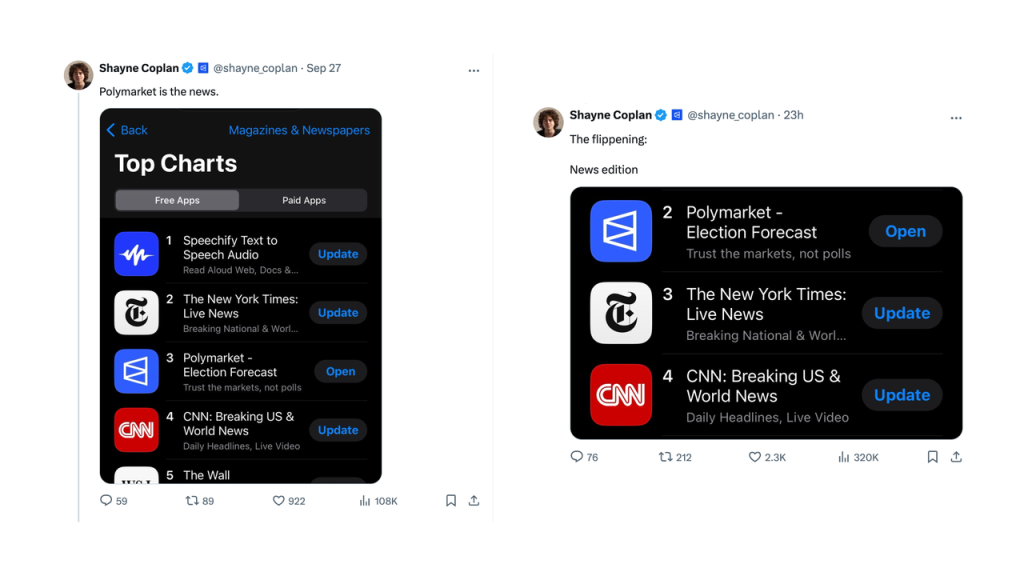

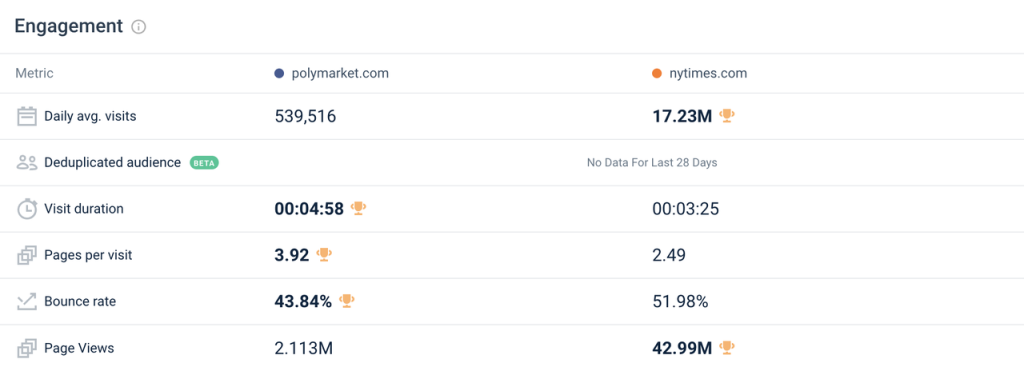
Source: Similarweb
Special Traders
Polymarket doesn’t need a large editorial team, the core content production is carried out by traders who put real money on the line. These individuals are Polymarket’s intellectual assets. The concept of prediction markets and their historical failures both highlight the importance of market participants. Their rational analysis and continuous re-evaluation of new information form the foundation of the market’s ability to be “accurate.”
A 2022 study on online horse race betting behavior involving over 40,000 Finnish residents showed that individuals with higher numerical IQs (i.e., those who perform better in tasks measuring arithmetic reasoning, problem-solving in mathematics, and quantitative analysis) displayed a significantly higher willingness to engage in skill-based gambling (as opposed to luck-based gambling). The study also found that approximately 9% of players had net gains compared to their losses. In Polymarket, this proportion is 11.5%.
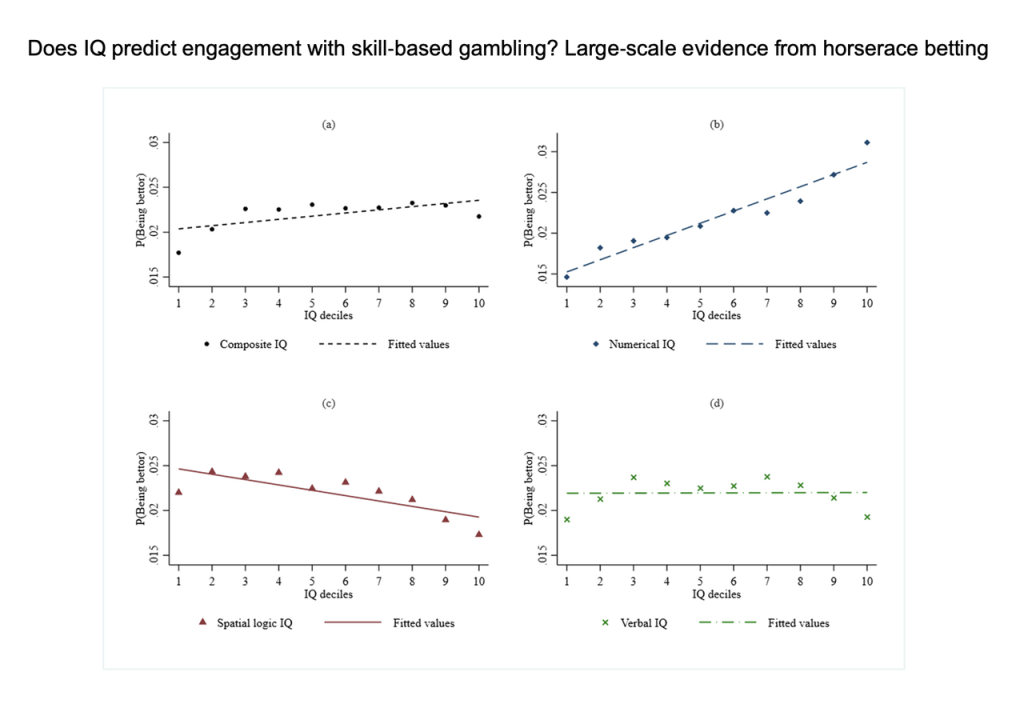
(b): Numerical IQ is significantly positively correlated with the willingness to participate in horse race betting
(c): Spatial logic IQ is significantly negatively correlated with the willingness to participate in horse race betting
(d): Verbal IQ is not correlated with the willingness to participate in horse race betting
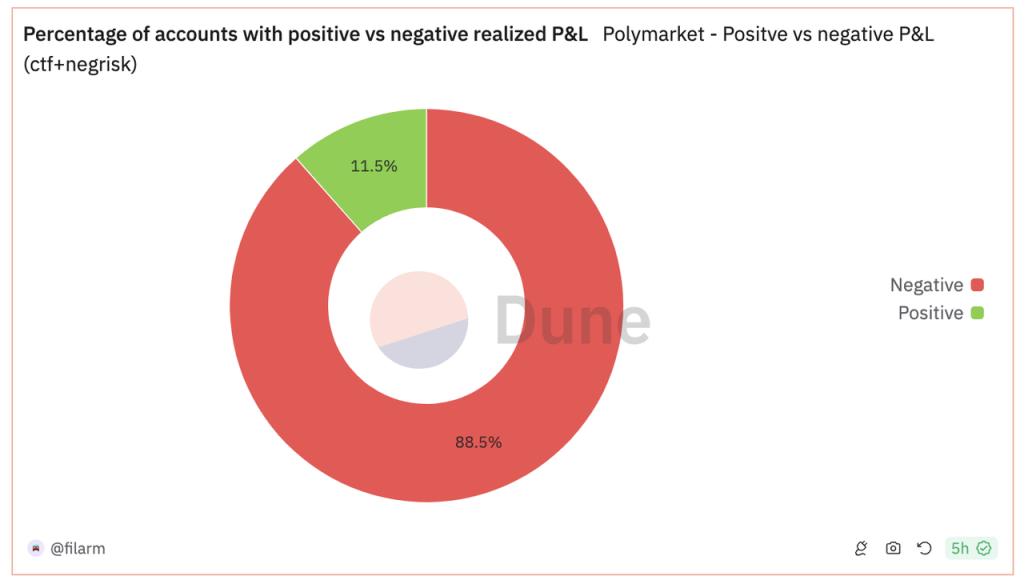
The sources of Polymarket’s ad traffic also reveal some strategies regarding “what kind of people they are attracting and converting.”
- The top-ranked source, electionbettingodds.com, is a well-known election prediction market aggregator, which consolidates data from five prediction markets, including Polymarket.
- Citizenfreepress.com is a U.S. political news aggregation site with a conservative slant, where half of the users are American males over the age of 55.
- Natesilver.net is the Substack of statistician, writer, and poker player Nate Silver. Nate developed an election forecasting system that successfully predicted the outcomes in 49 out of 50 states in the 2008 U.S. presidential election, and in June of this year, he joined Polymarket as an advisor.
- Among the top 10 traffic sources, only Coindesk and DappRadar are primarily focused on crypto-native users.
- Compared to platforms like Opensea and Pump.fun, Polymarket’s user age distribution is more balanced, with a significantly higher proportion of users over the age of 35.
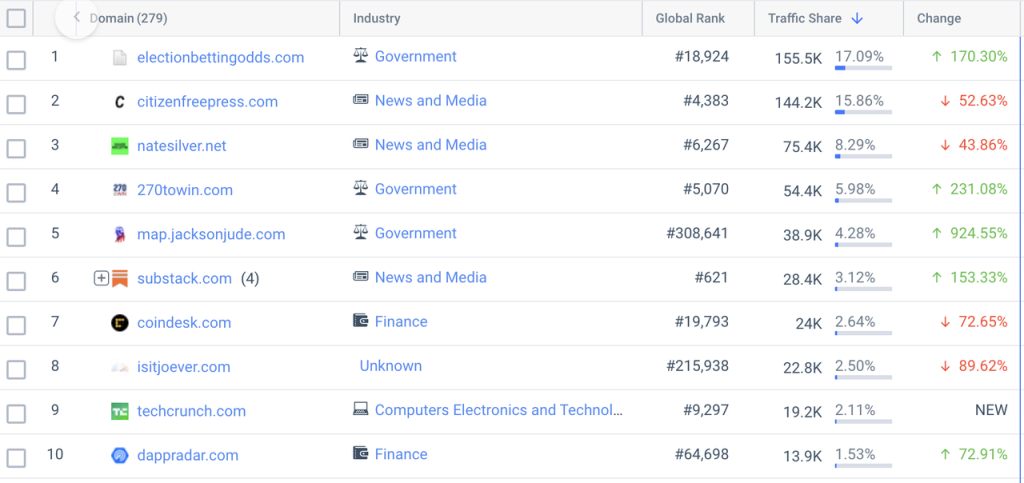
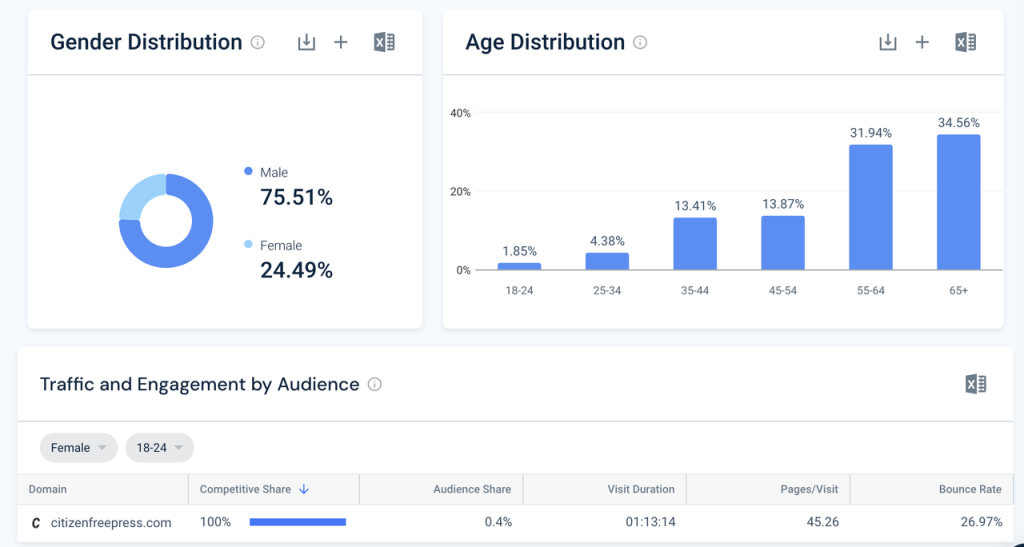

Source: Similarweb
We’ve rarely heard stories of “legendary traders” on Polymarket. This is determined by the nature of prediction markets—where the odds are controlled within a reasonable range to prevent outcomes from deviating significantly from the actual probabilities of events.
The data from Polymarket’s leaderboard supports this. Currently, only 3 users have total profits exceeding 1 million, while on pump.fun, there are 197 addresses with total profits of over 1 million, Considering that Polymarket’s active users in September amounted to 14% of pump.fun’s and that Polymarket was founded in 2020, the likelihood of getting rich via Polymarket seems much smaller.
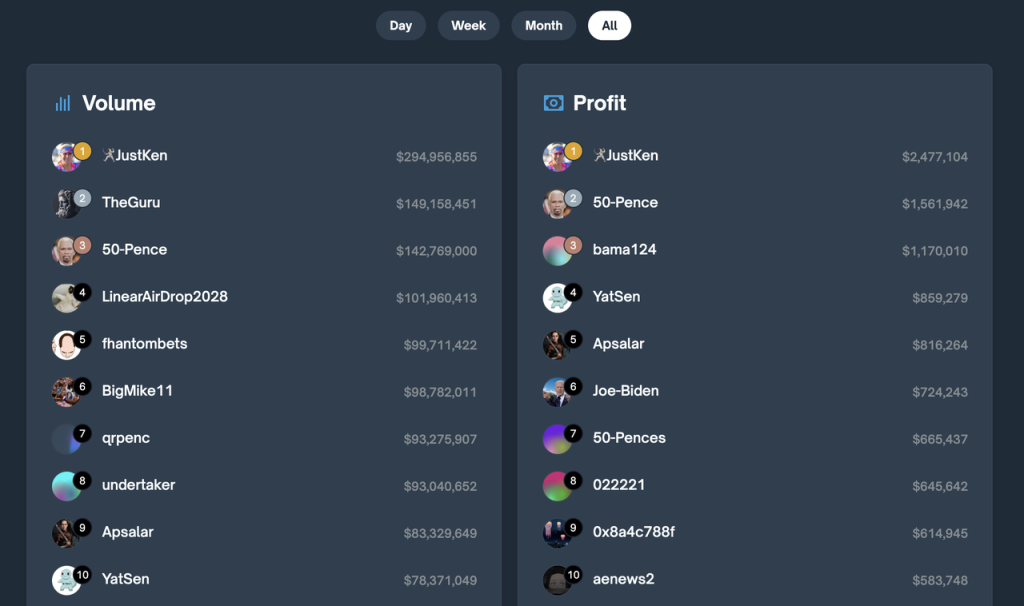
Correspondingly, Polymarket’s trading features are relatively restrained. Aside from deposit and withdrawal options, it only offers the most basic market and limit order features. Although it open-sourced its lending protocol Polylend in June, which allows users to collateralize assets to borrow USDC, Polymarket made it clear that this feature would not be used in production and is mainly for the community to build on. Moreover, Polymarket has not carried out large-scale liquidity incentives. Polymarket seems to believe that overly complex trading features could distract users from their main focus, while market-making and liquidity incentives could distort the market’s effectiveness.
Although it’s difficult to estimate the actual conversion rate from ‘reading the news’ to ‘trading,’ we can still sketch a rough profile of the ideal Polymarket user base — this is a relatively rational and mature group, likely with limited prior knowledge of cryptocurrencies. They are typically more economically stable, not chasing extreme risk-reward ratios, but rather enjoying the satisfaction of proving themselves right through analysis and sound judgment. This profile falls far from the typical image of a crypto degen and is a group that most Web3 products currently struggle to reach.
Stalling: The Critical Month of November
In aviation terms, “stalling” refers to a situation where the angle of an aircraft’s wing against the airflow becomes too great, failing to generate enough lift, causing a rapid loss in altitude. Pilots must lower the nose and increase thrust to restore lift and regain control of the aircraft.
Polymarket’s rapid ascent and its “flagship product” strategy around the election have raised concerns within the market about its ability to maintain momentum—what will happen after the U.S. election on November 5, when the dust settles? After all, Polymarket is not short of fierce competitors, ambitious new entrants, and vocal critics.

Polymarket’s Strategic Moves
For Polymarket, the results of this election are of utmost importance. The outcome will affect the credibility of the prediction market itself, as well as determine whether Polymarket can successfully separate the political biases of its team and investors, and truly “represent the public opinion.”
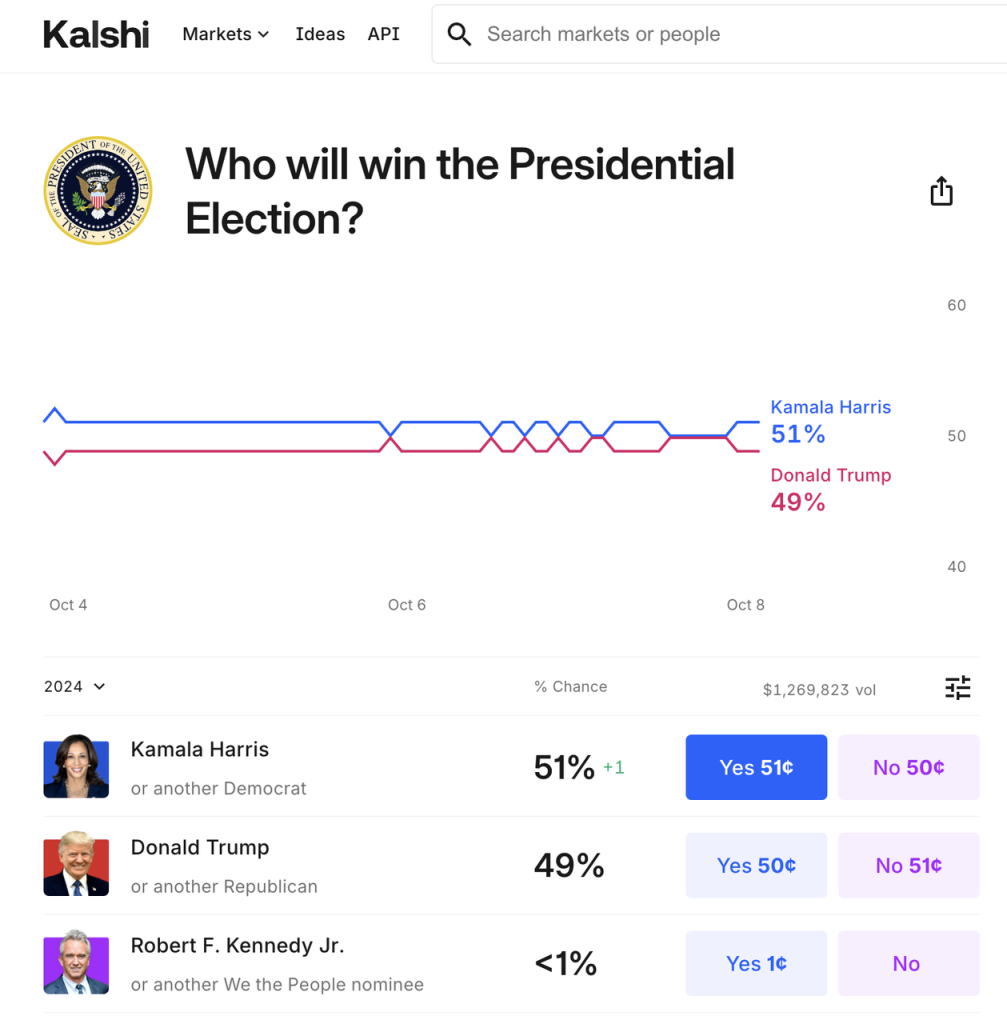

After the election, in response to declining trading volume and a loss of users, the discussed strategies for Polymarket (which are also areas that new entrants are eyeing) can be broadly categorized into three types:
- Expanding into sports betting
Sports currently represent the second-largest category of events on Polymarket, only behind elections. However, the trading volume in sports still lags behind elections by a significant margin, possibly due to spillover traffic from election topics. Whether this traffic can be retained long-term after the election remains uncertain.

Let’s set aside the fact that sports betting is an extremely fragmented and saturated market and that it isn’t a core area for prediction markets in the first place. Fans often place bets driven by emotions, seeking instant gratification and to enhance the viewing experience, rather than aiming for long-term profits. This is fundamentally at odds with the filtering logic of a prediction market.
- Expanding Derivatives Trading
This is also a saturated market and would undoubtedly be playing to Polymarket’s weaknesses rather than its strengths.
- Becoming the “Pump.fun of Events”
This has been a popular idea, envisioning an open market where anyone can create an event and make predictions. It seems to address a key limitation of Polymarket, where users cannot freely create markets, and the team must centrally curate and list events. However, if we break down the most popular election-related events, we will notice that elections themselves have certain key characteristics:
- Wide-reaching impact → adequate liquidity
- Long duration with multiple intermediate events → ensures full dissemination of information
- Definitive timeline and binary outcome → clear settlement
Likewise, Polymarket’s event listing criteria consider factors such as:
- Whether there’s sufficient trading demand to produce accurate probabilities
- Whether the event’s probability outcome has social or news value
- Whether the event will yield a clear result within a defined time frame
For most people, coming up with a clearly defined binary question, expressing it in unambiguous yet accessible language (without being too technical), and setting a clear point and standard for settlement—all while ensuring that the outcome holds some societal significance—is much more difficult than simply uploading a picture and launching memecoins.
Even Polymarket has faced controversies, such as with issues related to “ETF approval” or “Did Trump’s son participate?” where the criteria were unclear. If Polymarket became a fully open market, the risks of abuse (e.g., events like “Will Trump say a certain word at his next speech”) and disputed rulings (e.g., how to define whether Trump participated or not) would place a huge burden on the platform.
Thus, we can see that these three seemingly relevant directions for Polymarket’s transformation are far from straightforward. The core issue lies in the fact that Polymarket finds it difficult — and shouldn’t attempt — to strengthen its trading and speculation attributes. Even with rumors of issuing its own token, Polymarket must be cautious with how it uses incentives, focusing more on rewarding high-quality questions and correct outcomes rather than sheer trading volume.
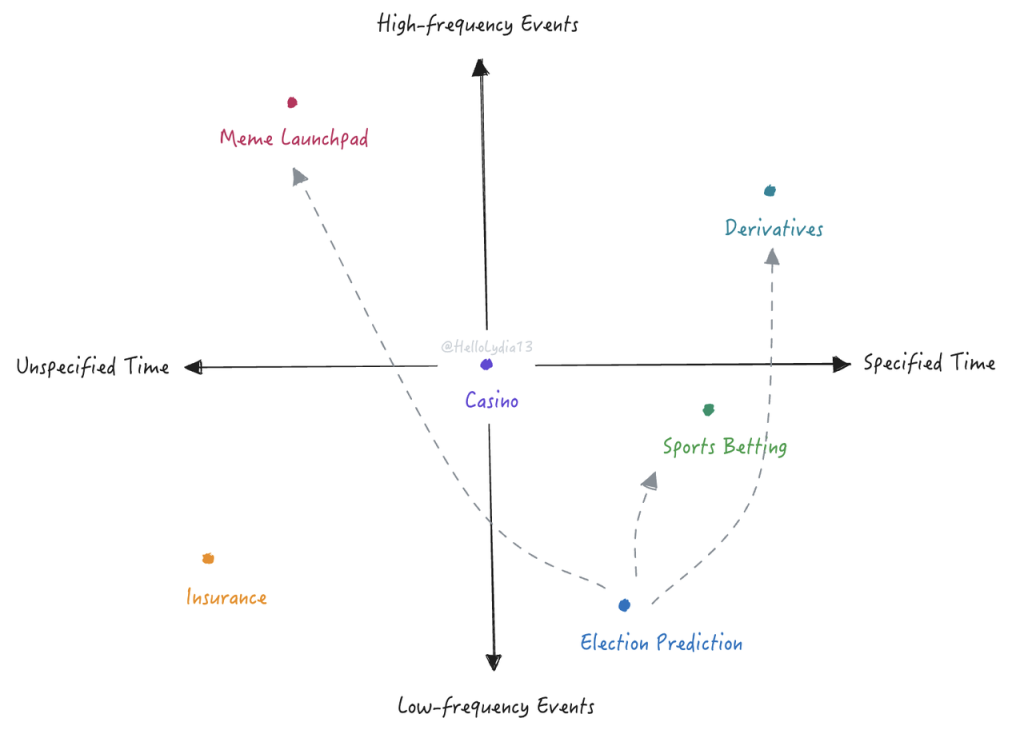
Regulation in the Room
Before the regulatory landscape becomes more clear, Polymarket’s token might not arrive as quickly as expected.
Markets tied to betting have always been subject to strict regulation. In 2022, Polymarket was ordered by the CFTC (Commodity Futures Trading Commission) to pay a 1.4 million fine and cease U.S. operations. This May, the CFTC released a proposed rule aimed at banning all derivatives trading related to U.S. elections. Also, in May, during the announcement of a 70 million funding round, Polymarket stated its mission is to provide the public with more accurate and real-time event predictions as a public service.
Good news arrived in the final weeks before the election. Following the ruling last month by the District Court of Columbia in favor of election prediction markets, a federal appeals court also rejected the CFTC’s request to block election betting. Previously, the CFTC had issued a warning stating that “the use of such contracts could negatively impact the integrity of elections or the public’s perception of election fairness.”
Once again, the market’s focus shifts back to the results Polymarket is about to deliver.



